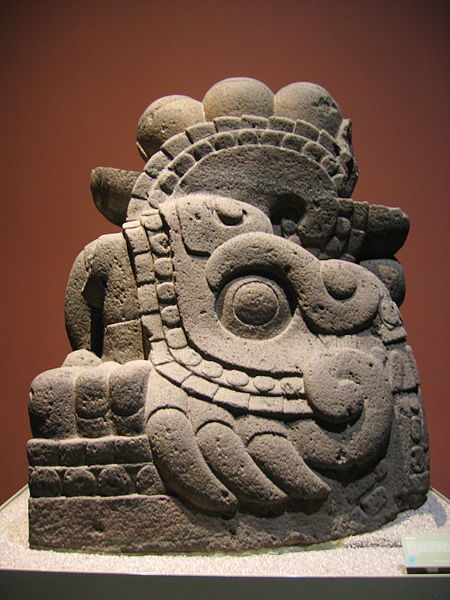In Aztec religion, Xiuhcōātl was a mythological serpent, regarded as the spirit form of Xiuhtecuhtli, the Aztec fire deity sometimes represented as an atlatl or a weapon wielded by Huitzilopochtli. Xiuhcoatl is a Classical Nahuatl word that translates as "turquoise serpent" and also carries the symbolic and descriptive translation of "fire serpent".
An Aztec sculpture of Xiuhcoatl from Texcoco, now in the British Museum
An Aztec sculpture representing the left-facing head of Xiuhcoatl
Huitzilopochtli as depicted in the Codex Borbonicus with Xiuhcoatl held up in his right hand as a weapon
In Aztec mythology, Xiuhtēcuhtli, was the god of fire, day and heat. In historical sources he is called by many names, which reflect his varied aspects and dwellings in the three parts of the cosmos. He was the lord of volcanoes, the personification of life after death, warmth in cold (fire), light in darkness and food during famine. He was also named Cuezaltzin ("flame") and Ixcozauhqui, and is sometimes considered to be the same as Huehueteotl, although Xiuhtecuhtli is usually shown as a young deity. His wife was Chalchiuhtlicue. Xiuhtecuhtli is sometimes considered to be a manifestation of Ometecuhtli, the Lord of Duality, and according to the Florentine Codex Xiuhtecuhtli was considered to be the father of the Gods, who dwelled in the turquoise enclosure in the center of earth. Xiuhtecuhtli-Huehueteotl was one of the oldest and most revered of the indigenous pantheon. The cult of the God of Fire, of the Year, and of Turquoise perhaps began as far back as the middle Preclassic period. Turquoise was the symbolic equivalent of fire for Aztec priests. A small fire was permanently kept alive at the sacred center of every Aztec home in honor of Xiuhtecuhtli.

Xiuhtēcuhtli as depicted in the Codex Borgia
Statue of Xiuhtecuhtli in the British Museum.
The mask of Xiuhtecuhtli, from the British Museum, of Aztec or Mixtec provenance.
Xiuhtecuhtli in his role as one of the lords of the night, from the Codex Borgia.







